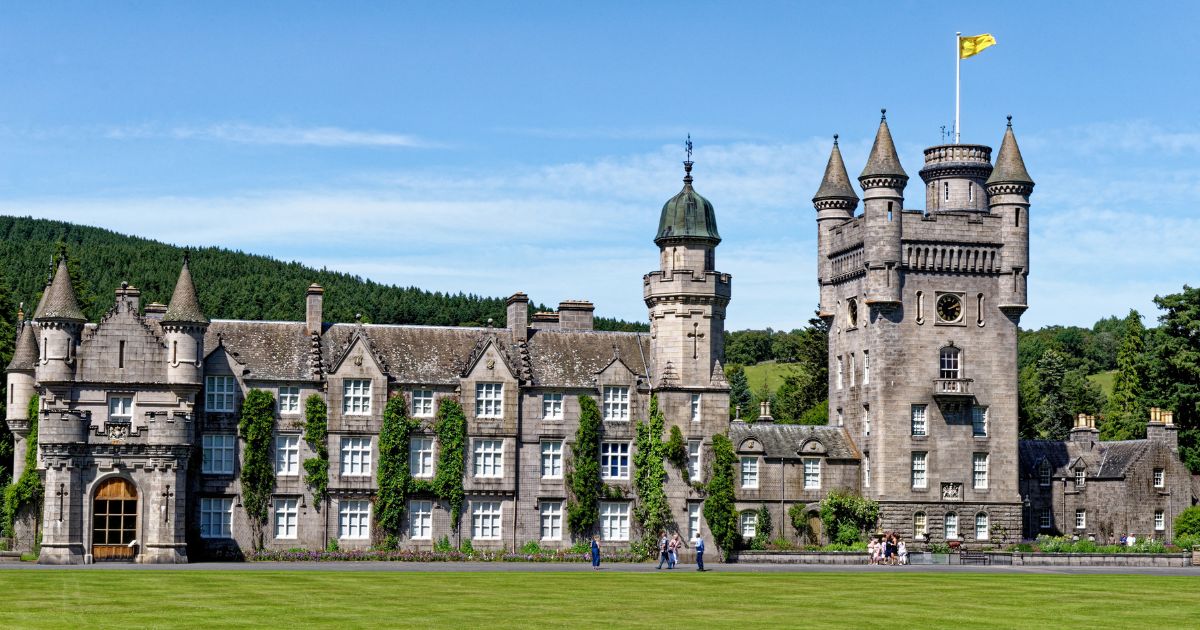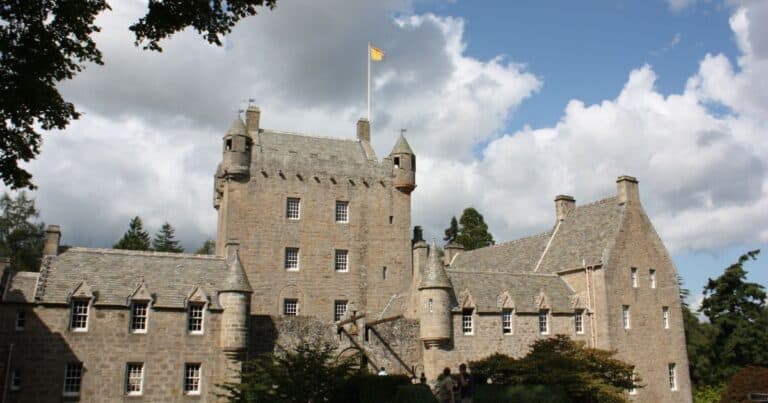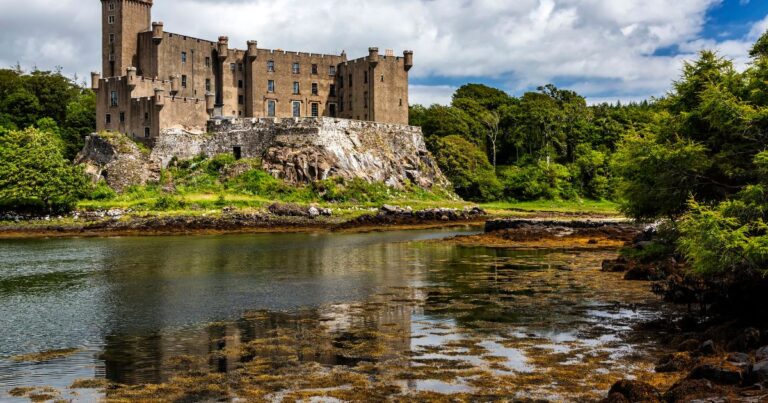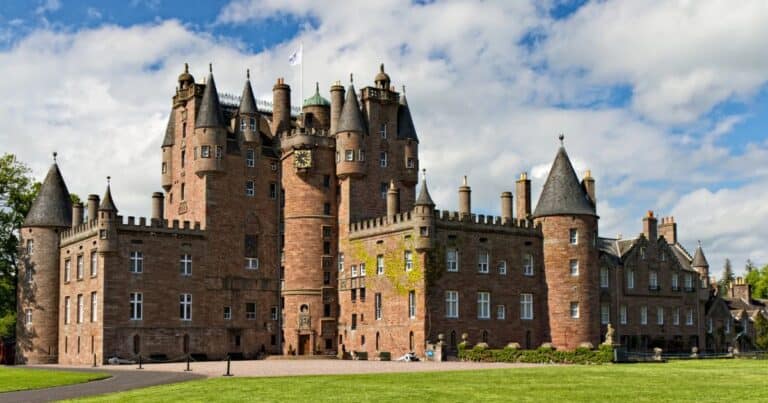Balmoral Castle: Inside Scotland’s Royal Retreat in the Highlands

Balmoral Castle is one of the most famous royal residences in the world – a Highland estate personally beloved by generations of the British Royal Family, cherished for its privacy, rugged scenery, Victorian architecture, and deep emotional history. Set alongside the River Dee in Aberdeenshire, Balmoral is more than a castle: it is a working estate, a landscape, and a retreat that has shaped personal and national stories for nearly two centuries.
As a long-time travel advisor and castle lover who has spent years exploring royal sites across Europe, I can say that Balmoral offers an experience unlike any other Scottish estate. The combination of romantic turrets, sweeping Highland views, immaculate gardens, forested walking trails, and authentic royal history makes Balmoral one of the most atmospheric properties you can visit.
This guide brings together the full story of Balmoral Castle – its origins, design, royal connections, estate life, gardens, visiting logistics, and the best ways to make the most of your trip.
Historical Snapshot
- Region: Royal Deeside, Aberdeenshire
- Founded: 1390s (original tower house)
- Rebuilt: 1850s (current castle designed by Prince Albert & William Smith)
- Style: Scottish Baronial
- Famous For: Royal holiday residence, Victorian architecture, emotional significance to the modern Royal Family
- Still in Use: Yes — private royal residence; public access is seasonal
- Best For: Royal history fans, architecture lovers, garden enthusiasts, Highland travelers
Planning a broader trip through the region? You can Explore Scottish Castles here.
Table of Contents
Historical Overview

Balmoral Castle’s history spans more than 600 years, beginning as a medieval tower house before becoming the Highlands estate that defined the Victorian era. The castle as we know it today is largely the vision of Queen Victoria and Prince Albert, who fell in love with the rugged Highland scenery during a visit in 1848.
If you’re interested in exploring more historic fortresses across the country, visit our full Castles in Scotland Guide.
The original Balmoral house was deemed too small for royal needs, so Prince Albert personally designed the new castle in the Scottish Baronial style. Construction took place between 1853 and 1856, blending romantic aesthetics with practical estate function. When Victoria inherited the throne, Balmoral became her sanctuary – a place where she walked, rode, painted, and mourned.
Victoria’s descendants have continued that tradition. Balmoral has played a central role in the lives of modern royalty – a beloved refuge where they spend late summers and autumns, away from ceremony and public duty.
Architectural and Design Highlights
Balmoral Castle is one of the finest examples of 19th-century Scottish Baronial architecture, a style that blends romantic medieval references with elegant Victorian craftsmanship.
What makes Balmoral special is how intentionally it was designed: every turret, gable, and granite surface reflects Prince Albert’s personal vision for a Highland retreat that felt both royal and deeply Scottish. The result is a castle that is not only picturesque, but architecturally rich, cohesive, and full of character.
Scottish Baronial Façade
The exterior of the castle immediately sets the tone with its iconic Baronial details. From the conical turrets and crenellated battlements to the crow-stepped gables and decorative finials, every element contributes to the castle’s romantic profile. Balmoral’s pale grey granite glows beautifully in sunlight and mist – a look that contrasts with the surrounding forest and hills, emphasizing the castle’s role as a royal landmark in an otherwise wild landscape.
Prince Albert’s Architectural Vision
Prince Albert was not content to simply remodel an existing property; he wanted a purpose-built estate that expressed the Royal Family’s love of Scotland. Working closely with architect William Smith, Albert influenced the placement of the central tower, the proportions of the windows, the layout of interior rooms, and the overall symmetry of the new design. His hand can be seen in the clean lines, harmonious balance, and understated elegance that make Balmoral feel both grand and intimate.
The Clock Tower
One of the most recognizable features of Balmoral is its clock tower. Rising above the rest of the castle, it anchors the structure visually and serves as a symbolic “center point” of the estate. The tower’s height, crenellations, and narrow turreted corners reflect medieval Scottish fortresses, while its Victorian details give it a softer, more polished appearance.
Estate Buildings and Working Architecture
Balmoral is not only a residence – it is a functioning estate. The surrounding buildings are designed with both beauty and practicality in mind. Stables, workshops, staff cottages, storehouses, and the estate offices all follow the Baronial aesthetic, creating a cohesive architectural language across the entire property. Even the bridges, gates, and stone walls were designed with care, giving the estate a unified, storybook feel.
Inside Balmoral Castle: What You’ll See
Although only a portion of Balmoral Castle is open to the public, what visitors do see offers an intimate and surprisingly personal glimpse into the private world of the Royal Family.
Rather than feeling like a museum or staged exhibition, Balmoral’s interiors reflect the lived-in warmth of a cherished summer home – a place filled with family memories, traditional Scottish décor, and objects with real emotional history. The rooms open to visitors vary year to year, but the overall experience centers on atmosphere, craftsmanship, and subtle royal storytelling.
The Ballroom
The Ballroom is the only major interior room consistently open to the public, and it is far more impressive than the word “ballroom” might suggest. This vibrant gallery-style space features:
- High, open timber ceilings typical of 19th-century estate architecture
- Royal portraits, including works depicting Queen Victoria and Prince Albert
- Exhibited heirlooms, such as uniforms, ceremonial dress, and personal artifacts
- Fine Victorian furnishings arranged to show how gatherings were once held here
Seasonal exhibitions sometimes include curated displays tied to the Royal Family’s history at Balmoral, offering a sense of nostalgia and continuity. The Ballroom’s scale and detailing make it the architectural showpiece of the public experience.
Victorian Furnishings & Personal Artifacts
Although access to private rooms is limited, the objects on display help tell the story of Balmoral as a beloved royal retreat. Expect to see:
- Gifts presented to Queen Victoria during her reign
- Personal items used during royal stays
- Estate artwork featuring Highland scenery and royal activities
- Photographs of generations of the Royal Family at Balmoral
These artifacts bring human dimension to the estate, illustrating how much Balmoral meant to Victoria – and still means to the modern monarchy.
Recreated Royal Spaces (Seasonal Displays)
Depending on the year’s exhibition theme, portions of the estate occasionally include recreations of royal sitting rooms, workrooms, or Highland-themed interiors inspired by Queen Victoria’s original designs. These shows highlight Balmoral’s signature blend of Scottish country style, including:
- Tartans used throughout the estate
- Antler furniture, popular during the Victorian period
- Carved wooden pieces sourced from local artisans
- Patterned wallpaper reflecting Victorian taste for nature-inspired motifs
Visitors often comment that these displays make Balmoral feel unusually personal for a royal residence – more like a Highland family lodge than a formal palace.
The Estate Workshops & Working Areas
Adjacent to the main castle buildings, Balmoral’s workshops and working facilities reveal the castle’s practical side. These areas help maintain the vast estate and support seasonal operations. While not all are accessible, exterior views of the stables, garages, and work buildings show the full scale of a functioning royal estate – one that has historically included forestry work, estate farming, and grounds maintenance.
Balmoral Castle Grounds, Gardens and Estate Life

The grounds of Balmoral are where the estate truly comes alive. This is not just a castle with gardens — it’s a vast Highland landscape of forests, rivers, meadows, and carefully managed natural beauty. Much of the Royal Family’s connection to Balmoral has always been rooted in outdoor life: walking, fishing, riding, picnicking, and simply enjoying the freedom and privacy that the Highlands provide. Visitors get a glimpse of that world through beautifully maintained gardens, paths, and estate buildings.
The Formal Gardens
Designed during Queen Victoria’s era and continuously developed through the reigns of subsequent monarchs, the formal gardens combine Victorian structure with natural Highland charm. Expect to see:
- Seasonal flower beds planted with vibrant displays during spring and summer
- Neatly clipped hedges and borders, echoing traditional Victorian garden design
- Aromatic herb plantings used historically for the estate kitchens
- Colorful perennials and roses, chosen to thrive in the northern climate
These gardens soften the granite castle façade and frame it with color — especially beautiful from May through August.
The Vegetable Garden
Originally cultivated to supply fresh produce for the Royal Family, the vegetable garden remains an active, working part of the estate. Visitors may see:
- Glasshouses where delicate vegetables and flowers are grown
- Orderly rows of seasonal crops, meticulously maintained
- Fruit trees and espaliered shrubs trained along warm stone walls
- Estate gardeners at work, depending on the time of day
This is one of the elements that makes Balmoral feel like a living residence rather than a historical relic.
The Estate Grounds & Scenic Walks
The wider estate covers over 50,000 acres of forest, moorland, and riverside terrain — and while most of it remains private, visitors still enjoy glimpses of its natural beauty. Accessible areas near the castle feature:
- Woodland paths lined with Scots pines and birch
- Sweeping lawn areas with views toward the surrounding hills
- River Dee viewpoints, offering classic Highland scenery
- Wildlife spotting opportunities, including red squirrels and estate birds
Even short walks on the grounds give visitors a sense of the calm and seclusion the Royal Family values so deeply.
The Stables, Courtyard & Estate Buildings
Around the castle you’ll see historic estate buildings that supported daily life:
- The stables, once filled with horses for riding and estate work
- The carriage house, reflecting the estate’s Victorian past
- Stone outbuildings, still used for estate operations
- Workshops and garages, part of Balmoral’s functioning infrastructure
These structures speak to the practical side of life on a large Highland estate — an important contrast to the ceremonial world of other royal residences.
Seasonal Atmosphere & Best Times to Visit
Balmoral’s appearance shifts dramatically with the seasons:
- Spring: Fresh blooms, bright greens, and longer light
- Summer: Peak garden colors and the most vibrant estate atmosphere
- Autumn: Golden foliage across the hills and pathways
- Winter: Moody Highland skies (though the estate is typically closed)
The combination of natural landscape, cultivated gardens, and historical architecture makes the grounds one of Balmoral’s most memorable features.
Notable Figures and Events
These individuals and moments shaped Balmoral’s identity:
- Queen Victoria — established Balmoral as the royal family’s Highland refuge
- Prince Albert — designed the new castle and estate structures
- Queen Elizabeth II — considered Balmoral her favorite residence and spent every summer here
- King Charles III — continues the tradition of seasonal stays
- Victorian expansions — created the gardens, ballroom, and estate cottages
- Modern royal gatherings — many family photographs, televised speeches, and personal stories trace back to Balmoral
The castle is often described as “the Royal Family’s true home.”
Legendary Tales and Local Lore
Balmoral Castle is not a place of medieval ghosts or ancient battles – its stories are quieter, more intimate, and deeply tied to the Royal Family’s life in the Highlands. These tales add warmth and personality to the estate, revealing why Balmoral has long been the monarchy’s most cherished private retreat.
Queen Victoria’s Highland Love Story
Queen Victoria and Prince Albert fell in love with the Scottish Highlands during their early visits, but Balmoral became their emotional anchor. Victoria described the landscape as “my dear paradise,” and the estate reflected their shared passion for nature, privacy, and family life.
Visitors today still sense this atmosphere – a retreat designed for joy rather than ceremony.
Royal Picnics and Outdoor Adventures
Balmoral has always been synonymous with outdoor traditions. There are long-standing stories of:
- Family picnics along the River Dee, complete with tartan blankets and portable stoves
- Fishing excursions, a pastime enjoyed by generations of monarchs
- Brisk walks in the hills, often in weather that would send most people back indoors
- Barbecue gatherings, a tradition famously embraced by Prince Philip
These anecdotes highlight Balmoral as the place where the Royal Family could simply be themselves.
The Ghillies Ball
One of the estate’s most charming traditions, the Ghillies Ball dates back to the reign of Queen Victoria. This annual event brings together estate staff, locals, and the Royal Family for an evening of Scottish music and dancing. Stories from the ball include:
- Monarchs joining the reels, laughing and dancing with the staff
- Kilts swirling through the ballroom, accompanied by fiddles and pipes
- A strong sense of camaraderie, symbolizing the close bonds between the estate workers and the Royals
It remains one of Balmoral’s best-loved traditions.
Royal Pets & Animal Stories
Animals have always played a large part in Balmoral life. Visitors often hear fond recollections of:
- Queen Victoria’s collies, who roamed the grounds with her
- Queen Elizabeth II’s corgis, who adored the estate’s open lawns
- Royal horses and ponies, used for riding, trekking, and estate work
These stories reinforce Balmoral’s image as a warm, lived-in home rather than a formal royal residence.
A Place of Solace for Monarchs
For many kings and queens, Balmoral has served as a sanctuary. Queen Elizabeth II was famously at her most relaxed here — walking her dogs, driving herself around the estate, and reading by the fire.
The estate’s peaceful rhythm has helped generations of monarchs reconnect with nature, family, and a sense of normalcy.
Why Visit Balmoral Castle
Balmoral Castle is unlike any other royal residence in Britain – not a fortress, not a ceremonial palace, but a deeply personal retreat shaped by generations of monarchs who found comfort, inspiration, and family life in the Scottish Highlands. Visiting Balmoral offers a rare chance to step into the private world of the Royal Family while exploring one of the most beautiful landscapes in Scotland.
Here’s what makes Balmoral such a rewarding stop:
A Rare Glimpse Into Royal Family Life
Balmoral is the monarchy’s private estate, not part of the Crown Estate — which means its history reflects personal stories rather than official state events. Touring the grounds gives visitors a sense of how the Royal Family relaxes, celebrates, and spends time together away from public duties.
Beautiful Baroque-Style Architecture
The castle’s Scottish Baronial design – complete with turrets, stone towers, dormers, and finely carved details – showcases 19th-century romantic architecture at its best. It’s elegant without being imposing, and it blends seamlessly with the Highland landscape that inspired its creation.
Expansive Highland Landscape
The estate spans over 50,000 acres of forests, riverbanks, moorland, and rugged hills. Visitors can enjoy:
- Peaceful riverside walks
- Shaded woodland trails
- Views toward the surrounding Cairngorm peaks
The natural setting is one of the estate’s greatest treasures.
Royal Traditions and Living Heritage
From the Ghillies Ball to long-standing outdoor rituals, Balmoral is rich in traditions that remain alive today. The estate feels lived-in, warm, and unmistakably personal — a home shaped by more than a century of royal memories.
Gardens Designed for Beauty and Practicality
The formal gardens, vegetable plots, and greenhouses remain in active use each summer. Seasonal blooms, neatly kept grounds, and views toward the castle create a peaceful setting that feels both elegant and intimate.
A Central Stop on a Royal-Themed Scotland Itinerary
For travelers exploring the Highlands, Balmoral pairs beautifully with nearby sites such as Braemar, Crathie Kirk, and other Deeside estates. It’s a perfect addition to any journey through Scotland’s royal and historical landmarks.
Visiting Balmoral Castle Today: What To Expect
A visit to Balmoral Castle feels very different from touring a fortress or royal palace — it’s more like stepping into a serene Highland estate where the Royal Family genuinely lives and relaxes. The experience is peaceful, scenic, and surprisingly intimate, with a strong focus on the surrounding nature and the estate’s working traditions.
Seasonal Access & What’s Open
Because Balmoral is a private royal residence, access varies throughout the year. Most visitors come during the spring and summer public season, when the grounds, gardens, and selected exhibitions are open.
Inside the castle itself, the Ballroom is typically the only major interior space accessible to the public – and even that varies based on the Royal Family’s schedule. Exhibitions displayed here change yearly, often featuring royal artifacts, estate history, or items linked to Queen Elizabeth II’s time at Balmoral.
The Arrival Experience
Your visit begins at the estate entrance, where paths lead through peaceful woodlands toward the castle. The first views of the granite façade, framed by the surrounding hills, make a strong impression – elegant but understated, just as it was designed to be.
Interpretive panels and staff guides help visitors understand the estate’s working role, from environmental stewardship to seasonal farming and woodland management.
The Pace & Atmosphere
Unlike cities like Edinburgh or busy sites like Stirling, Balmoral has a slow, tranquil rhythm. Most visitors spend their time strolling the gardens, exploring outdoor paths, and enjoying the scenery.
Expect a very relaxed, self-paced experience – perfect for travelers who enjoy nature as much as architecture or history.
The Ballroom Exhibition
If open during your visit, the Ballroom is the highlight. It may display:
- Personal royal artifacts
- Historical documents
- Artworks connected to the Royal Family
- Items from state gifts or ceremonial pieces
- Seasonal rotating exhibits
Because this is the only traditional interior space available, take your time – it’s the closest glimpse into royal life visitors typically receive.
Photography
Photography is widely allowed outdoors, where you’ll find countless scenic angles of the castle, gardens, and surrounding landscape. Indoors (especially in the Ballroom), photography rules may vary by season and exhibit.
Time Needed
Most visitors spend 1.5–3 hours touring the estate, depending on how much time they dedicate to walking the grounds or exploring garden paths.
A Note on Privacy
Because Balmoral is an active royal residence, certain areas are strictly private and always off-limits. Paths are clearly marked, and signage helps guide visitors respectfully through the public areas.
Planning Tips for the Best Experience
A visit to Balmoral Castle is most enjoyable when you plan with the estate’s seasonal rhythm, rural location, and privacy requirements in mind. These tips will help you make the most of your day.
Book Early in Peak Season
Balmoral has a shorter visitor season than many Scottish castles, and tickets often sell out – especially in late spring and summer. Advance booking helps secure the date and time you want, and ensures access to any special exhibitions.
Check What’s Open Before You Go
Because Balmoral is an active royal residence, access can change based on royal schedules, estate operations, and seasonal events. Always verify:
- Which gardens are open
- Whether the Ballroom is accessible
- Any temporary closures or restrictions
The official website updates these details regularly.
Plan for a Relaxed Visit
Balmoral is best enjoyed at an unhurried pace. Wear comfortable shoes, bring layers for shifting Highland weather, and allow extra time for wandering the gardens or stopping at scenic viewpoints. Many visitors find the slower pace to be part of the estate’s charm.
Arrive Early for the Best Light
If photography is important to you, the early hours offer the softest light across the gardens and façade. Morning visits also tend to be quieter, making it easier to enjoy the pathways and viewpoints before they become busy.
Look for Wildlife Along the Trails
The sprawling estate is home to red squirrels, Highland birds, and deer. If you enjoy nature, consider extending your time beyond the castle area to walk one of the marked estate trails.
Use the Audio Guide
When available, the audio guide adds valuable historical and architectural context – especially since most of the estate is self-guided. It covers royal history, estate traditions, and stories behind the gardens and landscapes.
Know the Photography Rules
Outdoor photography is generally permitted everywhere on the grounds. Indoor photography rules vary depending on the exhibition in the Ballroom:
- Some exhibits allow photos
- Others may restrict flash or all photography
- Check posted signs upon arrival.
Allow Time for the Estate Roads
If you’re driving, note that the surrounding Highlands roads can be narrow and winding. Give yourself extra travel time, especially during busy summer weekends or if the weather is misty.
Stop at the Coffee Shop or Gift Shop
Balmoral’s café serves light meals, baked goods, and warm drinks – perfect after walking the gardens. The gift shop features Scottish crafts, estate-branded items, and occasional releases tied to the Royal Family.
Getting There
- By Car: Best option; parking available onsite
- By Bus: Limited services between Ballater and Crathie
- By Train: Nearest station is Aberdeen; onward bus or car required
- By Tour: Many Highland day tours include Balmoral
- By Foot/Bike: Popular cycling and hiking routes connect nearby villages
Visitor Information
Hours, ticket details, and seasonal schedules can change – be sure to double-check the official website before planning your visit.
Hours:
Seasonal – typically April through late August; castle interior access varies.
Admission:
Separate garden & ballroom fees; combination tickets available.
Accessibility:
Grounds mostly accessible; interior exhibitions somewhat limited.
Nearby Attractions
- Braemar Castle
- Crathie Kirk
- Royal Lochnagar Distillery
- Ballater village
- Cairngorms National Park
- Muir of Dinnet Nature Reserve
Frequently Asked Questions About Balmoral Castle
Is Balmoral Castle worth visiting?
Absolutely – it’s one of Scotland’s most atmospheric and historically important royal estates.
Can you go inside Balmoral?
Only the Ballroom and exhibition areas are open; the private royal rooms are not accessible.
When is Balmoral open to the public?
Typically April – August; the Royal Family resides here in late summer.
How long do you need for a visit?
1.5 – 3 hours depending on how much of the grounds you explore.
Is Balmoral still used by the royal family?
Yes – it remains their private retreat.
Can you see the royal gardens?
Yes – the formal gardens, kitchen garden, and surrounding grounds are open seasonally.
Are dogs allowed?
On-lead pets are allowed in certain outdoor areas; always check current policies.
Conclusion
Balmoral Castle is one of Scotland’s most enchanting estates – a place where royal history, Highland landscape, and Victorian architecture come together in a uniquely atmospheric setting. Whether you’re drawn by the romance of the Scottish Baronial style, the sweeping river views, or the emotional legacy of Queen Victoria and Queen Elizabeth II, a visit to Balmoral offers a rich and memorable experience.
If you’re exploring more of Scotland’s remarkable heritage, pair Balmoral with Stirling Castle, Edinburgh Castle, Glamis Castle, Eilean Donan Castle, and discover even more in my full Castles in Scotland Guide.
For another striking Highland landmark in the north, consider visiting Dunrobin Castle, famous for its fairytale turrets and seaside gardens.






